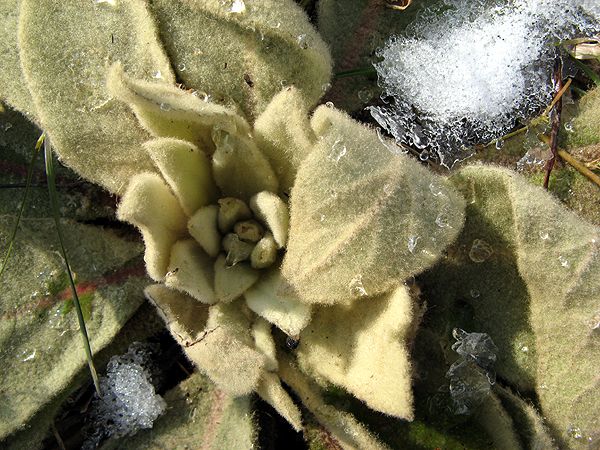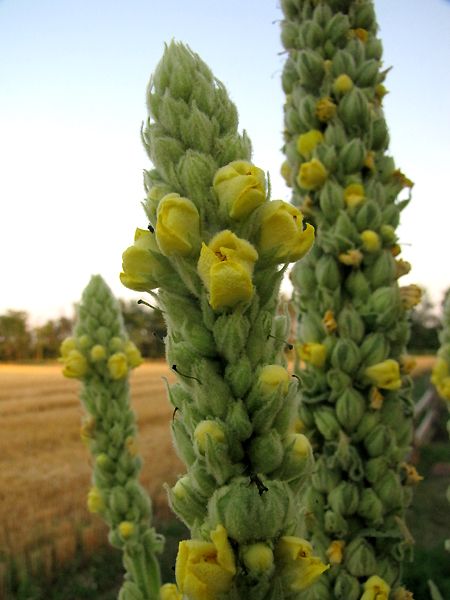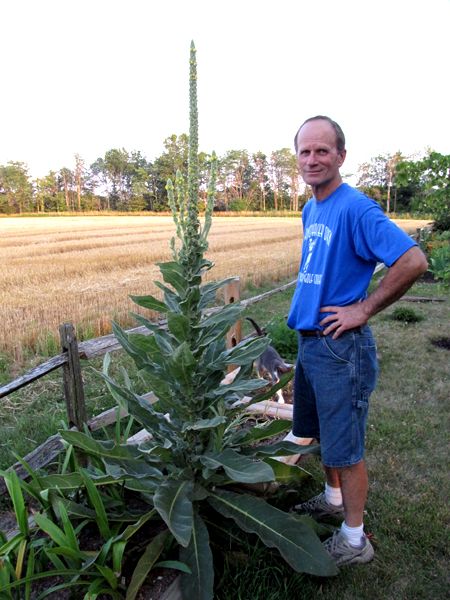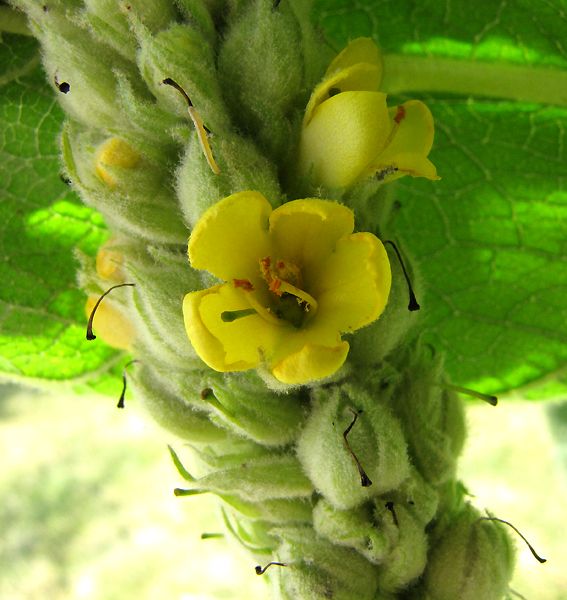 Two winters ago, Romie and I took a walk down the old railroad bed in my hometown. Being winter, not much was looking green, but we noticed a fuzzy plant that seemed to be laughing at the frigid temps and the snow. It fascinated me and when spring came, we returned to dig it up for relocating in our garden.
Two winters ago, Romie and I took a walk down the old railroad bed in my hometown. Being winter, not much was looking green, but we noticed a fuzzy plant that seemed to be laughing at the frigid temps and the snow. It fascinated me and when spring came, we returned to dig it up for relocating in our garden. 
Soon I learned that our little plant was Common Mullein (Verbascum thapsis) and that it wasn't going to stay little for long. I planted it in a mostly shaded spot in the heart of Max's Garden and that first summer (2008), it shot out a flower spike that grew to maybe four feet tall, but I'd expected taller.

This photo was taken on July 9th and at this point it was just over seven feet tall (Romie is 6' 1"). Today, just ten days later, it stands more than eight feet tall, is sprouting auxiliary stems, and shows no signs of slowing down.
How high can it go?
 Great Mullein or Common Mullein
Great Mullein or Common MulleinVerbascum thapsus
Zone 4-10
Common mullein blooms from June through September. Plants must reach a critical size before flowering is initiated, which normally occurs during the second year but may be delayed until the fourth year of growth.
An individual plant produces up to 240,000 seeds. Seeds have no special mechanisms for dispersal and usually fall close to the parent plant. Once buried in soil, they can become dormant and survive for years. Common mullein seeds buried in soil have remained viable for more than 100 years.
- 'Mullein' is from the Latin 'mollis' meaning soft.
- Leaves of common mullein have been used as lamp wicks and Romans used plants dipped in fat as torches.
- Leaves of common mullein were placed inside shoes for warmth.
- Quaker women, forbidden to use makeup, rubbed the leaves on their cheeks to give the appearance of wearing rouge. The hairs on the leaf caused an allergic reaction to the skin, thus turning the skin red.
- A yellow dye made from common mullein flowers was used by Roman women to color hair.

















 "Bejeweled"
"Bejeweled"



14 comments:
Without checking, I'd be willing to bet this is in the same general family as foxglove; they both have soft leaves, grow in spiky stalks like that, and the flowers grow in such compact rows. I'm drying some foxglove flowers I got from Mt. Baker that I'll plant later, along with some hollyhock seeds I have.
I just love the tall English garden-type flowers like this.
I too just love this wild plant. I have seen a number of birds clinging to that tall bloom eating the seeds and picking bugs off of it.
That is a big Mullein!!! I think I would get it out, but maybe you have the space for it. In full bloom I am sure it is beautiful.
Tee ~ Yes, you're right, they are both members of the Scrophulariaceae family. This mullein's leaves are MUCH softer than foxglove's though. These feel like a blanket!
Funny you should mention English gardens. One of the Master Gardeners that just visited Our Little Acre mentioned that she thought Max's Garden looked like an English garden. Maybe a cottage garden...
Lisa ~ I'm not sure I love it, but it's definitely unique! I'll always grow it because of that and I love feeling its leaves!
Janet ~ It's okay growing it where it is, but I doubt I'd have it in my regular gardens. It's a fun plant, but I don't think I'll let it go to seed. Did you read how those things are?? Yikes!
I love mullein--it's mostly a roadside "weed" in MI, but it was planted ornamentally all over CO--it's a very water-smart plant!
I've been wanting to dig up a mullein for my garden. I want it for medicinal purposes to make some salve along with some comfrey and some beeswax.
It is such an interesting plant. They grow all around us in the ditches. I bet with all those seeds they provide a lot of food for birds.
I love mulleins, though I find the ornamental ones don't last well for me, with the exception of a white-flowered one with a little wine bee. It's been flowering here (from self seeded plants) ever since I bought a plant about nine years ago. I happen to love the wild ones too, because tI like the leaf texture and the statement the plant makes. It'll be fun to see how much taller this one grows, Kylee!
talk about a big plant! amazing! I wouldn't let it go to seed, either. Have you grown any of the new verbascum/ mullein plants? I've got one going (Caribbean sp? crush) and so far , so good.
Monica ~ Yep...roadside weed here, too, which is likely why I'd never noticed it much before - they get mowed down before they reach any height.
Chiot's Run ~ I would imagine the birds do love them! The bees sure do. It's usually got some on it at any given time.
jodi ~ They absolutely DO make a statement! I used to have a hybrid Verbascum - 'Jackie' - but it eventually died out after only a few years. :-(
This giant one's been fun!
Muum ~ I used to have 'Jackie' and loved its color and form, but it didn't last past a few years for me. I looked at 'Caribbean Crush' a few years ago, but didn't buy it.
Now that's what a call a serious weed! A real monster, yet interesting enough to grow in the garden. You are right, it was a red admiral, not a painted lady visiting my butterfly bush. He wouldn't open his wings enough for me to be sure. Since then, he practically lives here, but won't let me take his picture anymore! I have two bee balms, but haven't seen hummingbird moths there yet.
I always have a few mulleins somewhere in my border. I do have several Verbascum species, and not all of them grow as tall, but indeed, common mullein aften grows very tall. 7 to 8 feet isn't an exception!
I love them, they do very well as a solitary ornamental in my wildflower borders.
I always grow common mullein in my garden. They are fabulous plants - a biennial here. I don't worry too much about them seeding out -- the goldfinches eat most of the seed anyway -- and the plants are easy to move or weed out.
They are great to grow amongst white flowers, as they have almost a silvery glow about them. They are very architectural and do not require as big of a footprint as you might think. They will grow in just about any soil -- even soil with very little nutrients in it.
I use my mullein medicinally. The leaves and flowers when made into a tea make a very potent decongestant; far more effective than even guaifenesin. And the tea is VERY TASTY! Like a honey/flower green tea. (the tea MUST be filtered as the leaves have hairs that irritate the skin - hence the rouge effect when women would use it as make-up).
Transplanting it a couple of times can keep the height in check.
I have a HUGH Mullein that just came up last year. My hubby thought it was a weed and wanted it pulled up. I had never seen one before but quickly looked it up. I even bloged about it in May of 2011. (http://nonserenity.blogspot.com/search?updated-max=2011-06-01T10%3A15%3A00-04%3A00&max-results=7
I wish I had found your blog earlier. You have brought out an interesting point. Everything I have read says that the plant blooms in the second year and then dies, but you indicated that it lives longer. Which is it?
I love this plant and am looking to make a tea and salve from the leaves. Have you made either? And if so, how did it turn out? Any recipes? THANKS
Post a Comment